Historic Centre of Évora: Evora is situated in the heart of the Alentejo region of Portugal, about 130 km east from Lisbon. The history of the town of Évora goes back to the Neolithic period, the surrounding landscape of Évora comprises a large number of megalithic monuments, the most important are the Almendres Cromlech, the menhir of Almendres and the Anta Grande do Zambujeiro. Évora was a thriving town in the Roman Times, the Temple of Diana is a reminder of this period. Evora is still surrounded by its medieval fortified town walls. In the 15th century, Évora was the residence of the Kings of Portugal and became the second town of the country. The University of Évora was founded by the Jesuits in 1559, it was the second university founded in Portugal, after the University of Coimbra. The Jesuits were expelled from Portugal in the 18th century and the University of Évora was closed in 1779, the university was reopened nearly two hundred years later in 1973. One of the most remarkable monuments in Évora is the Chapel of the Bones in the Igreja Real de São Francisco, it is one of the most visited monuments in Évora. Another outstanding monument in Évora is the 16th century Agua de Prata Aqueduct. The Cathedral of Évora is a fine example of Gothic style, the design of the octagonal crossing tower resembles that of one of the towers of the Old Cathedral of Salamanca. It is common belief that, before the first expedition of the navigator Vasco da Gama to India in 1497, the flags of the fleet were blessed in the Cathedral of Évora. The Historic Centre of Évora gained the status as a UNESCO World Heritage in 1986.
www.werelderfgoedfotos.nl © Copyright World Heritage Photos Classic Car Road Trip
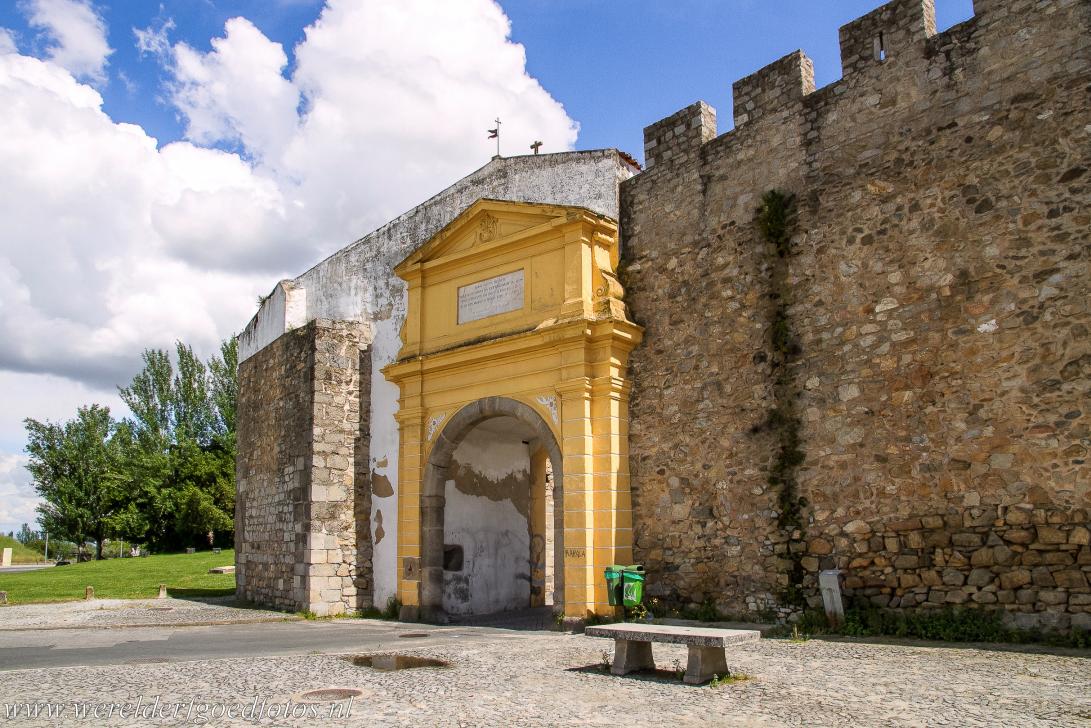
Historic Centre of Évora: The Porta de Avis, the Gate of Aviz, is one of the town gates of Évora. The gate was named after the House of Aviz, the second dynasty of kings of Portugal. Evora is situated in the heart of the Alentejo region, 130 km east of Lisbon. Évora is surrounded by cork oaks, vineyards and olive groves. The Historic Centre of Évora is a UNESCO World Heritage.

Historic Centre of Évora: The Porta de Avis, the Gate of Aviz, is one of the town gates of Évora. The gate was named after the House of Aviz, the second dynasty of kings of Portugal. Evora is situated in the heart of the Alentejo region, 130 km east of Lisbon. Évora is surrounded by cork oaks, vineyards and olive groves. The Historic Centre of Évora is a UNESCO World Heritage.
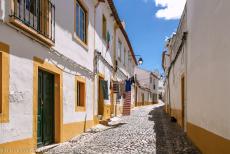
Historic Centre of Évora: A colourful alley in the old Jewish Quarter in Évora. The Jewish Quarter of Évora was one of the largest and richest Jewish quarters in Portugal. During the Middle Ages, the Jews of Portugal lived in their own quarters, known as the Judiarias, their rights were limited. The Jewish Quarter in Évora is situated near Praça do Giraldo, the Giraldo Square.
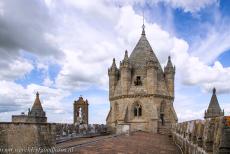
Historic Centre of Évora: Atop the Cathedral of Évora, the spire of the octagonal tower above the crossing of the transept is surrounded by six turrets Each turret is a smaller copy of the tower itself. The Cathedral of Évora is a magnificent example of the Gothic architecture. The design of the tower resembles that of one of the towers of the Old Cathedral of Salamanca.
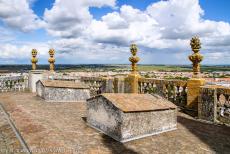
Historic Centre of Évora: It is possible to visit the rooftop of the Cathedral of Évora, the rooftop provides an amazing view over the town and the surrounding landscape. The Cathedral of Évora is a fine example of the Gothic. It is common belief that the fleet of the explorer Vasco da Gama, on his first expedition to the Orient, had their flags blessed in the Cathedral of Évora in 1497.
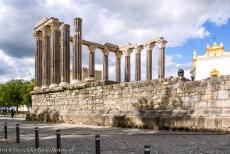
Historic Centre of Évora: The Roman Temple of Évora, also referred to as the Temple of Diana. The temple was constructed in the first century and dedicated to Augustus, the first Emperor of the Roman Empire. The temple is regarded as one of the best preserved Roman temples on the Iberian Peninsula. Twelve Corinthian columns and epistyles or architraves are still intact.
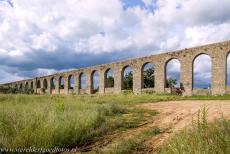
Historic Centre of Évora: The Agua de Prata Aqueduct, the Aqueduct of Silver Water, was built in the 16th century. The aqueduct transported fresh drinking water from the water springs of the Graca do Divor area to the town of Évora. The Agua de Prata Aqueduct is 18 km long, the tallest arch is 26 metres high. Once, the aqueduct was connected to the fountain in Praça do Giraldo.
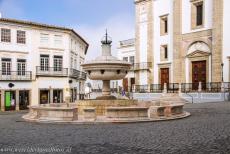
Historic Centre of Évora: The 16th century Fonte Henriquina stands in front of the Santo Antão, the Church of Saint Anthony. The Baroque marble fountain is situated in the Praça do Giraldo, the main square of Évora. The fountain sprays eight streams of water, they represent the eight streets leading out of the main square into the town of Évora.
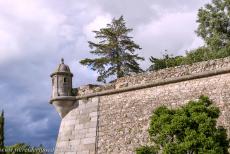
Historic Centre of Évora: One of the turrets in the medieval town walls of Évora, the oldest part of the wall was built in the third century. During the Arab rule (750-1165), the walls were further improved. A second wall was constructed in the 16th century and reinforced with bastions in the 17th century. The walls are still intact and surround the entire historic centre of the Évora.
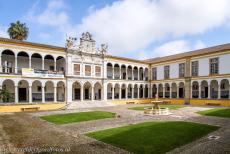
Historic Centre of Évora: The arcaded courtyard of the Colégio do Espírito Santo ( College of the Holy Spirit), the main building of the University of Évora. The Society of the Jesuits founded the university, the Jesuits were expelled from Portugal in the 18th century. The University of Évora was closed in 1779. The university was reopened in 1973, nearly two hundred years later.
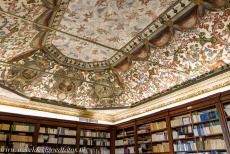
Historic Centre of Évora: The ceiling of the library of the University of Évora was painted around 1709, the central drawing depicts the Blessed Virgin, the Seat of Wisdom. The historic buildings of the university are spread out all over Évora. The Colégio do Espírito Santo, the College of the Holy Spirit, is the most important and most visited building of the University of Évora.
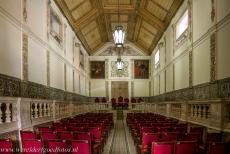
Historic Centre of Évora: The Old Sala dos Atos, the Old Conference Room of the University of Évora, situated in the Colégio do Espírito Santo. The Baroque room is decorated with colourful azulejos and decorative stucco from the 17th century. The University of Évora was founded by the Jesuits in the 16th century, it was the second university founded in Portugal.
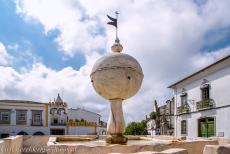
Historic Centre of Évora: The fountain in the centre of the Largo das Portas de Moura Square. The 16th century Renaissance fountain is topped by a marble sphere of the Earth. The 16th century Casa Cordovil, situated behind the fountain, was built in the Manueline and Mudéjar styles. Close to the square stands the Largo das Portas, a gate in the medieval walls of Évora.
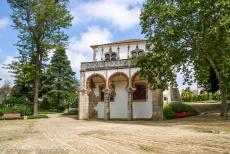
Historic Centre of Évora: The King Manuel Palace, also known as the Royal Palace of Évora, is a former residence of the Kings of Portugal. The palace was built as a convent in the 13th century, it was modified into a Renaissance palace in the 14th century, it was a centre of the Portuguese Renaissance. The palace is situated in the Public Parc of Évora, the Jardim Público de Évora.
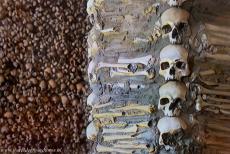
Historic Centre of Évora: The Capela dos Ossos, the Chapel of the Bones, is one of the most remarkable monuments in Évora. The chapel is located in the Igreja Real de São Francisco and is one of the most visited monuments in Évora. The chapel was probably built in the 16th century, about 5,000 human skeletons were used to decorate the walls, skulls line the pillars and ceiling.
